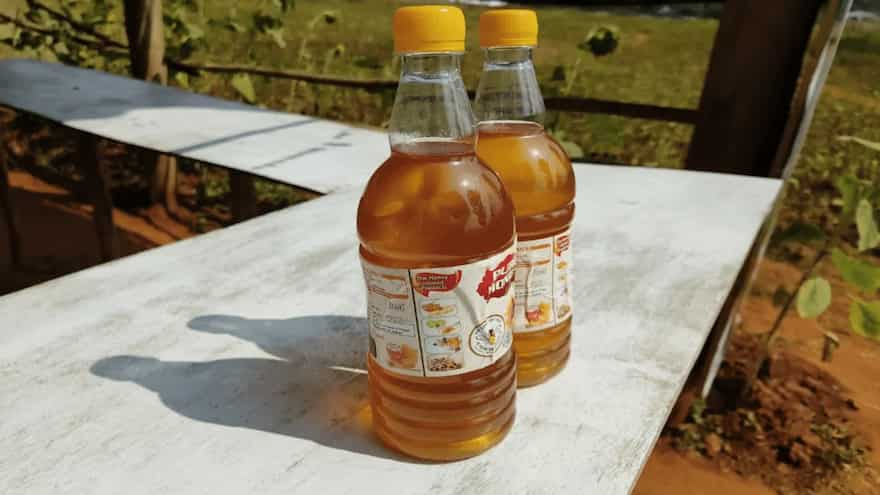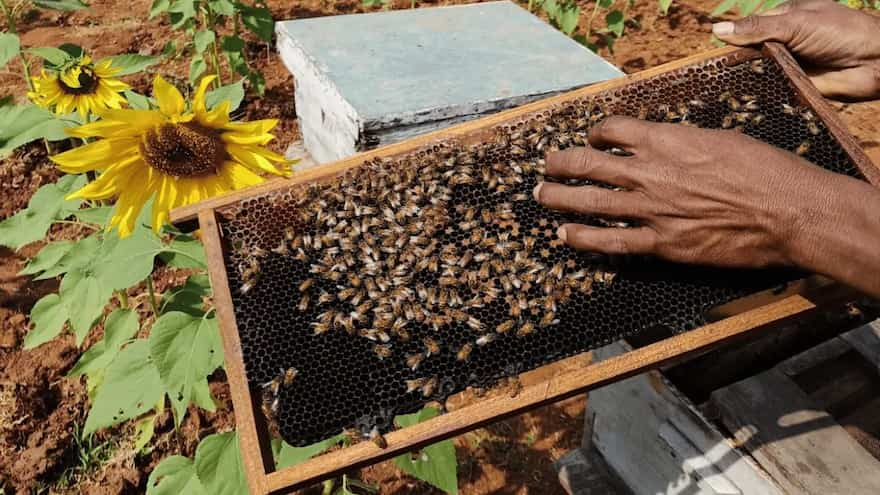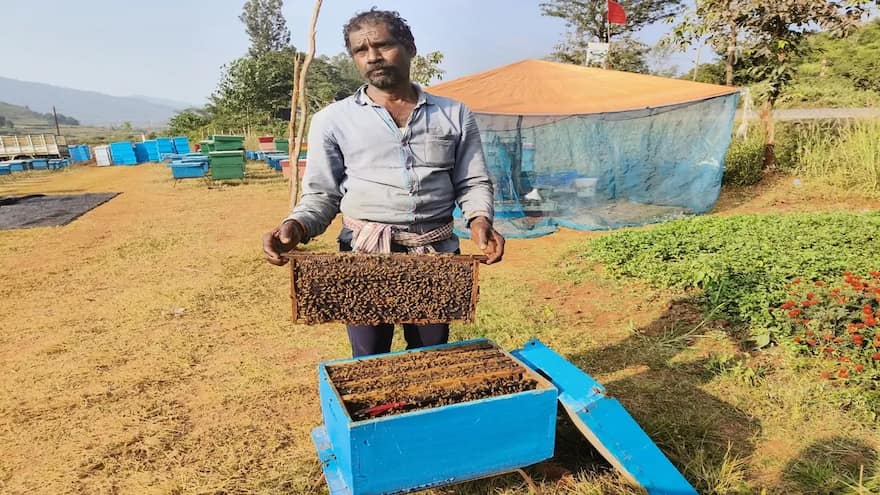Tucked in the Eastern Ghats, Araku needs no introduction to the outer world. This picturesque valley has long been attracting travellers, seekers, and tourists from far-flung lands. While it is dubbed a hill station and thronged by visitors during winters and monsoons as the mercury drops, Araku has also etched its unique offerings on the world's food map. A rich tribal region, this beautiful valley has managed to retain its purity and lets the urbanites taste the unfiltered charm of an array of edibles collected from nature. Many of us might have heard this hinterland's name, which has become synonymous with coffee. But, Araku's food stories transcend beyond coffee. Often a distinctive element of Araku that goes unnoticed is its organic and natural honey.
The best way to discover it is by being attentive and looking at both sides while walking or driving on the roads of this enamouring valley, especially the stretch from Araku to Chaparai waterfall. Hundreds of bright blue, green and yellow wooden boxes make a 'beeline' on either side of the path. Welcome to the world of 'Araku honey'. Embark on this journey with me, and let's explore this untapped nectar of Araku valley.

Honey harvesting beehive boxes in Araku honey farm, Image By: Ranita Ray
Araku honey farmers and farms
Nearly a hundred honey farms in this small region are harvesting honey. While a few of them stay here around the year, a few others prefer the season time, which is in winter. The honey is produced naturally by the bees from the host flowers. Boxes containing several honeycomb trays are placed in the flower field. These wooden containers are beehives. Mohan Honey Bees Industries is among the pioneers in this sector and entered Araku honey harvesting almost two decades back.
During an unplanned trip to Araku, I decided to be like the bees and understand how sweet the entire process of making honey from flower nectar and pollens to our tables is.
Honey from the nectar of Valise and other flowers
Araku, especially its Dumbriguda Zone, wears a sunny yellow look during winter. Thanks to the season of valasulu flowers. These blooms are exclusive to the year's colder months, lasting from September to November. While these flowers' visual appeal draws tourists, the bees aren't spared either. Araku is carpeted with these tiny yellow flowers which appears to be a wild version of chamomile.
I learned about honey from these flowers when I stopped by Pure Gold Bee Farm Honey. Not the valasulu, but giant sunflowers blooms caught my attention. A board indicated, 'clicking pictures in the sunflower field is chargeable'.

Two bottles of honey at the sunflower and valise flower honey farm
I entered the honey farm and met Korra Onoth, the honey farmer and owner. A massive collection of honey in different flavours and colours was on display. This was when he showed me the most famous local variant, made with the nectar of valasulu puvvu or flower, as referred to locally. "This type of honey is extremely popular and well harvested by the Araku region tribals." Since these valasulu flowers are seasonal, the honey from the flower is harvested cyclically.

Korra at his honey harvesting farm
"We cultivate rice for the rest of the season, and in the idle season, after harvesting rice, we farm valasulu flowers for honey," told Korra.
He also informed me that the same flower seeds are used for extracting edible oil. These tiny yellowish blooms are called niger flowers in English. Apart from valisilu, sunflower honey is also harvested here. According to Korra, sunflower gives maximum yield. Both sunflower and niger flower score equally in granting health benefits. A few find the taste of sunflower honey better.
Valisilu honey has a dark hue, intense flavour and a bittersweet or mild spicy spike in its taste. It is nothing similar to what most of us have tasted in regular variants commercially sold. The honey from these host flowers' nectar has several health benefits.

Different harvested honey, Image By Ranita Ray
Araku and Valise flower
Valasa or valise farming was ancient and distinctive to this region, according to Visakhapatnam Agency veterans. To combat soil erosion, the soil conservation department recommended valise cultivation to the Araku tribe in the 1950s and 1960s. Only in the cold, foggy environments is valise suitable for cultivation.

Valise flowers
Pure, natural and organic honey
The honey collected in these farms of Araku is of the highest quality. They are devoid of any processing or adulteration. They ensure that no adulteration is done during the entire process, and it is 100% organic. Valasa has a strong flavour that is not similar to any variants available in the market. One can check the purity by a water test: A pure honey won't dissolve in water; it sits at the bottom of the glass or bowl.
At peak season, honey is harvested every 10 days and sold in a blink of an eye as tourists throng these farms. "We also harvest the raw forest and strawberry honey; as the name suggests, these are the source of the nectar. For example, strawberry honey beehives are placed in strawberry farms. The forest is wild honey which takes a natural process found mainly inside the dense forests of the Araku region. All these honeys have a shelf life without adding any preservatives unless adulterated," shares Onoth.
The queendom of bees
There are three types of bees in the entire honey harvesting process. The ruling entity is the queen bee, whose only work is to lay eggs. Rest two types are drones and worker bees. Fertile male honeybees, known as "drones," are essential to the continued existence of honeybee colonies. Their main job is to procreate with a receptive queen to assure future honeybee generations. As the name suggests, the worker bees work the hardest and are responsible for bringing nectar, and pollen, feeding the larvae and cleaning and maintaining the hive.

Bees on the honeycomb tray, Image By: Ranita Ray
When I moved to another farm, I met T Surya, who was extracting the honey from each tray from the wooden box beehives. Isn't he afraid of bee stings? He laughed and said, "bees and we share a symbiotic relationship. They know we aren't here to harm. We protect them." He let me hold a frame buzzing with bees and oozing with honey. And, as he said, none of them seemed in an attacking mode.

Holding a honeycomb tray filled with bees, Image By: Ranita Ray
He explained what was there in those blue and green wooden containers. "Each box is a beehive, and there resides one queen bee, one hundred drones, and around one lakh worker bees populate each hive. They are only opened when the beekeeper needs to inspect them or remove the honeycomb frames. Bees enter and exit the box through a little hole at the bottom."
Don't the bees get confused about which box to enter? The answer was a clear no! What an intelligent being a bee is!

The honey is extracted from honeycombs by scaping the wax cap manually. After removing the caps, the honey is extracted from the comb by spinning the frames in a hand-spun extractor.
It is collected in a vessel placed at the nozzle of the extractor with a piece of cloth that works as a filter. Later it is filtered once again, packed in bottles, and put up for sale.

Pure honey collected in a pot, Image By: Ranita Ray
Araku and the honey market
According to the Araku honey cultivators, different kinds of honey are identified according to colour and taste. They also informed me that the mass cultivation of honey farming is not done yet. "The market is so large that honey cultivators like us needn't store our honey in cold storage. Generally, all the product is consumed by the end of the season."Korra has been into honey farming for 5 years, and he further adds that this is better than paddy cultivation owing to the high returns in the short term.
There are also naturally flavoured honey variants prepared in Araku. The flavours include garlic, ginger, rose, beetroot, and carrot. Srinivas from Mohan Indian Honey explains the making of these special varieties, "To make these honey variants, we soak the ingredients of each type in raw Araku cultivated honey for 41 days. After this period, the old honey is replaced with fresh one and pounded with the soaked ingredients.

Garlic honey at Mohan Indian Honey farm
Garlic honey is good for weight loss and works as an aphrodisiac, jamun honey is ideal for diabetes, ginger is for curing cold cough, and rose honey has benefits in healing women's reproductive health." He also informed me that they do in-depth research on various ingredients and their benefits when blended with honey and thus make these naturally flavoured ones.
By the end of this expedition, I was humbled by the knowledge that how harvested honey from host flowers has been a measure to keep the bees protected. And a small tribal valley like Araku is among the leading flagbearer of a honey revolution.
Season: The season of honey harvesting from Valasi flowers spans from September to November.
Visiting Araku honey farms: A few farms stay active all year, and visitors can experience honey harvesting in the natural process.
Host flowers for nectar: Apart from valise or niger flowers, sunflower and strawberry flowers are used for honey farming. The wooden beehive boxes are placed in the farms cultivating these flowers.


